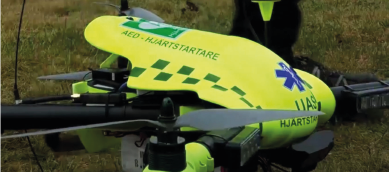Out of all medical emergencies, cardiac arrest is one of the deadliest and the most time critical. Even when emergency services arrive quickly to the scene, only 1 in 10 people will survive.
The likelihood of survival doubles(!) if someone on site can deliver CPR and use an automated external defibrillator (AED) before the ambulance arrives. If an AED can be placed within 5 minutes of cardiac arrest the likelihood of survival is at it’s highest.
The University of Carolina conducted a pilot study (published on 17th September - https://www.nejm.org/doi/full/10.1056/NEJMc1915956), using an autonomous flying drone to deliver an AED to the incident site as quickly as possible. Five different geographical zones were tested to represent different environmental challenges to drone navigation and AED delivery. Variables included: distance from drone launch site to incident site, visibility and number of fixed AED in the area. In each test a mock call to emergency services triggered a drone to be launched at the same time a person at the incident site set off on foot to find a fixed AED near the scene.
In all zones the drone delivered the AED inside of 5 minutes from the point of cardiac arrest. Most (89%) of participants reported feeling safe and comfortable knowing the drone was on it’s way and when it was approaching. On the other hand, those searching for a fixed AED on foot reported high stress and difficultly locating the device. The main retrieval time on foot varied greatly and was over the 5-minute threshold in 3 out of 5 zones.
All the participants reported that they would be willing to access an AED drone-delivery system in a true out-of-hospital cardiac arrest.
This poses an exciting opportunity to not only improve, but to more than double survival in out of hospital cardiac arrest, by integrating drone technology into our emergency response teams. Drones can easily deliver an AED to suspected cardiac arrests withing the 5-minute window before paramedic arrive, and alleviate stress for those on site delivering CPR.
.jpg?width=342&height=509&name=OrtusAcademy(YELLOWGradient).jpg)




Leave Comment